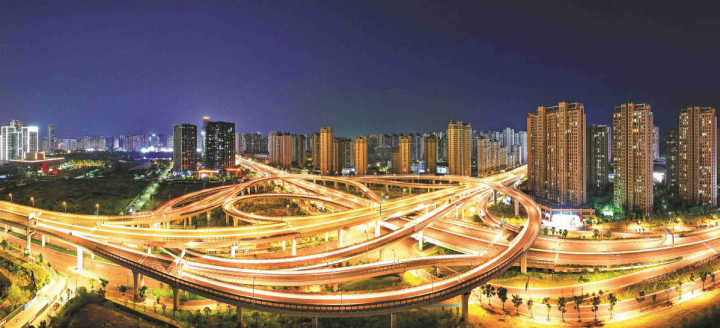Roads at heart of poverty alleviation in China
Expressways have linked rural and urban areas in the country, greatly speeding up urbanization. ZHU HAIPENG/FOR CHINA DAILY
Report by World Bank, State Council outlines lessons learned from 40-year effort
It took two years of field visits and workshops for the World Bank and Chinese authorities to identify the drivers behind the country's poverty alleviation over the past 40 years. But it took Kenneth Quinn four decades to conclude that building roads paved its way to prosperity.
Earlier this year, the 189-member global lender, working with the State Council's Development Research Center, released a report entitled "Four Decades of Poverty Reduction in China: Drivers, Insights for the World, and the Way Ahead", an examination of the factors behind the historically unprecedented feat of lifting close to 800 million people out of poverty and what lies ahead.
The report concluded that China's success is derived from rapid economic growth and broad-based economic transformation that opened up opportunities and raised the incomes of the poor.
It was also founded on effective governance, which ensured the implementation of both its growth strategy and targeted poverty-reduction policies.
For Quinn, president emeritus of the World Food Prize Foundation, which is based in Iowa in the United States, China has undergone the most dramatic transformation of any country since 1978, mostly because it has eliminated extreme poverty.
Last year, the country declared that it had eradicated extreme poverty as defined by the national threshold, and that it had lifted 770 million people out of poverty since 1978, contributing to nearly three-quarters of the global reduction in the number of people living in extreme poverty.
The eradication of absolute poverty in the world's most populous country in just 42 years is a "truly extraordinary" achievement, said Quinn, who is also a former US ambassador to Cambodia and who has chaired the World Food Prize Foundation since 2000. "The most essential lead element in China's poverty alleviation efforts was the construction and improvement of farm-to-market roads that were repaired and rebuilt everywhere," Quinn told China Daily.
He said that over the past four decades, he has visited the nation on multiple occasions to observe its poverty-reduction process and to interact with key participants and decision-makers.
On his first trip in October 1979, as part of a delegation of US state governors, Quinn found widespread poverty. He remembered meeting with then-Chinese leader Deng Xiaoping, who emphasized the importance of the two steps China had just taken: its new policy of "opening to the world" and the establishment of diplomatic relations with the US.
Quinn said that during that trip, he had the "remarkable opportunity" to travel across the country to observe the economic situation firsthand in areas such as Shanghai, Guangdong province and the Guangxi Zhuang autonomous region. Approximately 750 million Chinese citizens were then mired in poverty, and there was no sign of the modernization that is now ubiquitous nationwide, he said.
In the 1960s, Quinn served as a rural-development adviser in the Mekong Delta. It was there that he first realized that places that lacked roads were rife with poverty, hunger and malnutrition. In China's case, impoverished areas began to recover once roads were built.
"A comparison of 1980 Chinese highway maps with those of 2020 demonstrates the clear linkage between the improvement and upgrading of rural roads and the reduction of poverty throughout the country," Quinn said.
For one thing, the upgrading of all-weather roads was the means by which new agricultural technologies, enhanced nutrition and expanded educational opportunities became available, he said.
Lin Anhui (second from right), a college graduate from a village in Fu'an city, Fujian province, teaches her fellow villagers to sell agricultural produce through livestreaming on Aug 10. JIANG KEHONG/XINHUA
Sustained public investment in infrastructure, particularly in transportation, was a catalyst for China's domestic market integration, providing the poor with improved access to markets to sell their produce and catering to their consumption needs.
It also allowed the gains from China's export-led development and managed urbanization to be shared with interior provinces and rural areas, according to the joint study released by the World Bank and the State Council, China's Cabinet.
To get a better sense of the heavy investment in intercity expressways, the length of expressways increased by 44 percent annually, from 147 kilometers in 1988 to 25,130 km in 2002. By 2020, that figure had risen to 161,000 km.
In many areas, public investment in the construction of rural roads or irrigation infrastructure was designed to benefit low-skilled workers by incorporating local employment requirements in bidding documents, the study noted.
The researchers estimated that in the mid-1990s, every 10,000 yuan ($1,392) of public spending on roads may have moved three people out of poverty. The same amount also gave two people access to electricity and telecommunications at the time.
Compared with other parts of rural China, the effects were much greater in the western region of the country, where 10 people were lifted out of poverty for every 10,000 yuan spent on rural roads.
Quinn said that at a recent webinar hosted by the US Heartland China Association, for which he serves as a strategic adviser, participants discussed the poverty-elimination program carried out in Yunnan province. "Interestingly, it began with upgrading the old dirt road that ran through the province," he said.
Other researchers also highlighted the role played by the construction of roads, which was supported by instrumental government policy.
"China's state is endowed with high administrative capacity, and the government used this to provide public goods and overcome collective action failures," Maria Ana Lugo, senior economist at the World Bank, wrote in a blog with two colleagues.
The article was published on the Brookings Institution's website in September last year.
"This is most evident in the expansion of public infrastructure that helped integrate rural areas with urban economies, and in the coordination of stakeholders in targeted poverty reduction," the article noted.
Improving connectivity to drive poverty alleviation has become one of the insights shared with other developing countries.
In an interview with China Daily last month, Munir Akram, Pakistan's ambassador to the United Nations, said that the lessons Pakistan can learn from China are to make eliminating poverty and hunger a development priority, and to ramp up efforts to build roads and develop technology.
"We need greater support for small farmers. …We need farm-to-market roads to be able to take crops to the market. We need fair prices. We need better education systems. We need advanced technologies, which are applicable in order to grow better crops, better yields and in order to build the basis for food security," Akram said. "So there is much we can learn from what China has done."
Quinn said other factors that have contributed to China's rapid rise out of poverty include widespread increased educational opportunities; the large-scale integration of women into the workforce; and the creation of a well-trained administrative and civil service structure that successfully implements programs throughout the country.
Going forward, the challenge for China will be to maintain domestic economic growth while dealing with an array of significant international issues, including animal, crop and human diseases, climate volatility, water insecurity, and maintaining a peaceful regional and international environment in order to facilitate a stable global trading system.
Given the enormous global challenge of meeting the UN Sustainable Development Goals by 2030, and feeding the projected world population of 9 to 10 billion people by 2049, efforts to improve the bilateral US-China relationship would seem to be an overriding objective, Quinn said.
The UN SDG 2022 report, released in early July, estimated that up to 95 million more people could fall into extreme poverty this year.
Students play a traditional Dong ethnic stringed instruction at the Jiangchuan Primary School, a school for a community for relocated rural families in the Sanjiang Dong autonomous county, Guangxi Zhuang autonomous region, on June 16. LU BOAN/XINHUA
"One way of (improving the relationship) could be Sino-American collaboration to meet the single greatest challenge humankind has ever faced: whether we can sustainably and nutritiously feed the 9 to 10 billion people who will be alive in 2049," he said.
For example, the two largest economies could work together to upgrade the rural road infrastructure across the African continent.
"In doing so, China and the United States would be assisting African institutions by literally providing them a 'road out of poverty'," he said.
Jorge Chediek, the UN secretary-general's former envoy on South-South cooperation, noted that the policies China implemented to reach the most disadvantaged allowed for the targeting of resources and opportunities to populations that are generally the most difficult to reach.
He was referring to the point when poverty in China dropped below 10 percent of the rural population, which happened around 2012, and targeted poverty alleviation and social-protection systems began to play a more critical role in going "the last mile" to reach the pockets of the remaining poor.
He also added that since its launch in 1978, reform and opening-up had unleashed a period of massive economic growth, which in turn provided employment and business opportunities, spawning unprecedented increases in national income.
"This reform process has been very well sequenced in terms of sectors and geographical scope," Chediek, the visiting professor at Catholic University in Buenos Aires, Argentina, told China Daily.
He said China has set a powerful example for other developing countries.
"The first reason is that China has shown that enormous development can happen, starting from a very low base. Second, this process can happen in a relatively short period of time. Third, you do not need to follow some of the traditional prescriptions coming from the Global North," he said.

 扫描二维码
扫描二维码





 浙公网安备 33010502007539号
浙公网安备 33010502007539号